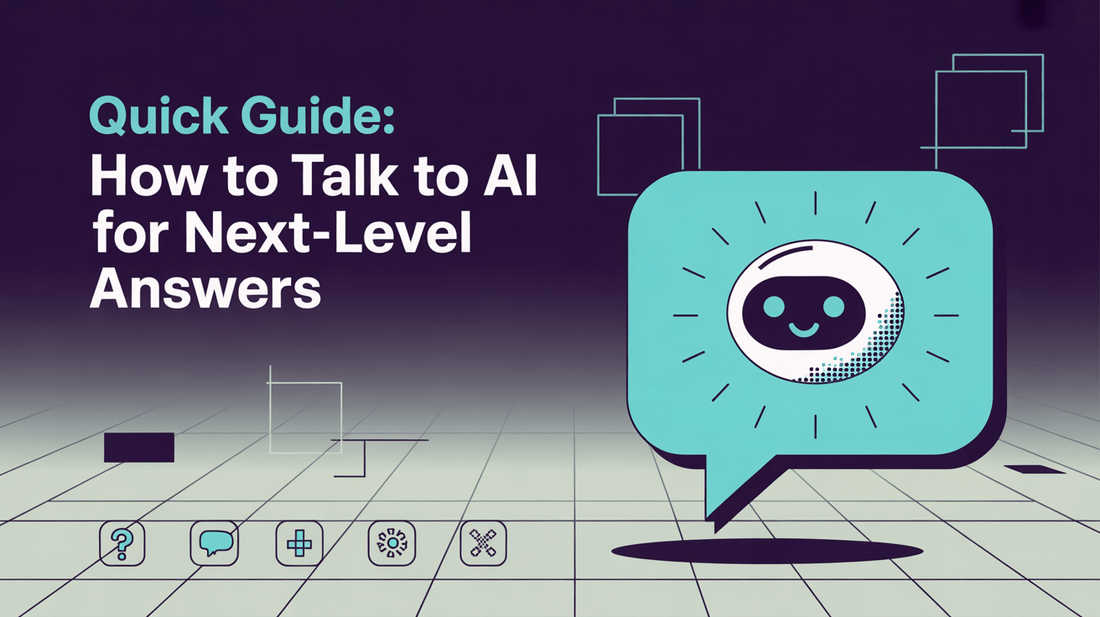
Quick Guide: How to Talk to AI for Next-Level Answers
⚡ Quick Guide: How to Talk to AI for Next-Level Answers
Most people stay at level 1: they ask simple questions and get simple answers.
But if you want your AI to feel more like a collaborator than a search bar, you need to learn how to push it deeper.
Here’s how to unlock that “click” moment and start getting results that feel tailored, creative, and truly helpful.
1. Frame the role, not just the task
Instead of just telling the AI what to do, tell it who it should be when doing it.
Basic prompt:
“Summarize this research paper.”
Advanced prompt:
“Act as a senior academic editor. Summarize this research paper for a journal’s editorial board. Keep the technical terms but highlight gaps where reviewers are likely to push back. Add a short note suggesting improvements for clarity.”
🎯 Why it’s better: You don’t just get a summary, you get insight.
2. Layer constraints + freedoms
AI loves boundaries — they focus its creativity. Give it a clear frame but also a playground.
Basic prompt:
“Write a social media campaign for a coffee brand.”
Advanced prompt:
“Draft 3 social media campaign concepts for a coffee brand targeting young professionals. Each must fit in under 200 characters per post. One concept should be playful, one aspirational, one controversial. Don’t repeat slogans, and end each with a call to action that feels native to Instagram culture.”
🎯 Why it’s better: You get variety, freshness, and usable copy — not generic marketing fluff.
3. Ask for process, not just output
Most people want the end product. Power users ask for the thinking behind it.
Basic prompt:
“Give me ideas for a mystery short story.”
Advanced prompt:
“Generate 5 mystery story premises. For each, explain what the narrative tension is, which character holds the biggest secret, and what kind of twist would subvert reader expectations. Then rank them by originality.”
🎯 Why it’s better: You get the raw material and the blueprint for why each idea works.
4. Use multi-step prompts deliberately
Don’t try to squeeze everything in one mega-prompt. Break it into deliberate steps, like a workshop.
Example workflow:
-
“List 10 possible taglines for a campaign about eco-friendly packaging.”
-
“Now group them into 3 themes.”
-
“Pick the strongest theme and refine it into 5 highly polished, brand-ready options.”
🎯 Why it’s better: You guide the AI through iteration, just like you would a human creative team.
5. Force perspective shifts
AI tends to produce neutral, “safe” outputs. Asking it to see through another lens can spark new angles.
Example:
“Rewrite this customer complaint response — first as if you were a calm therapist, then as if you were a witty stand-up comedian, then as if you were a no-nonsense military officer. Keep it respectful but distinct.”
🎯 Why it’s better: You quickly test tones and discover surprising voices you’d never try alone.
6. Go meta: make the AI critique itself
Don’t accept the first output — make it grade its own work.
Example:
“Draft a LinkedIn post about burnout. Then, as a social media strategist, critique your draft: is it likely to get engagement? Rewrite it to improve reach while keeping it authentic.”
🎯 Why it’s better: You turn the AI into both writer and editor, saving you the job of rephrasing weak drafts.
7. Use the “Goldilocks Zone”
Too vague = shallow output. Too rigid = robotic output. Aim for precisely framed but flexible prompts.
Example formula:
👉 [Role] + [Goal] + [Context] + [Constraints] + [Stretch]
“As a UX copywriter [role], write onboarding text [goal] for a fintech app that helps freelancers manage taxes [context]. Each screen max 15 words [constraint]. Add one playful twist per screen to reduce anxiety [stretch].”
🎯 That balance between structure and play is where the best outputs happen.
🚀 Final Takeaway
The trick isn’t asking more. It’s asking smarter:
- Define roles.
- Layer constraints.
- Demand process, not just product.
- Iterate.
- Shift perspectives.
Make the AI self-aware.
Do this, and your AI stops being a helpful calculator and starts acting like a creative partner.
Downoad Cheet Sheat here